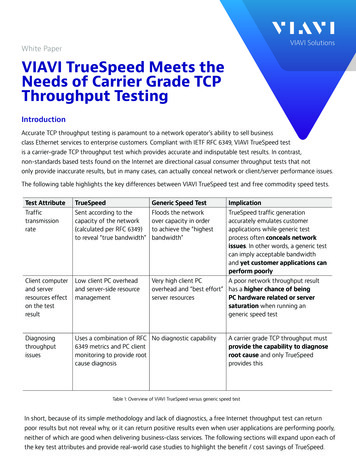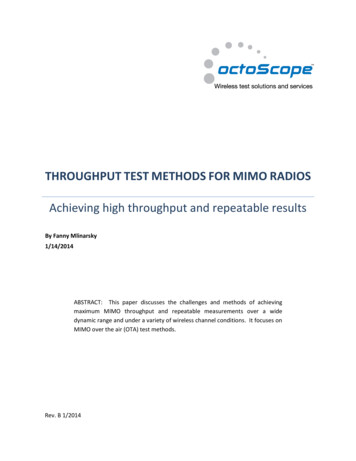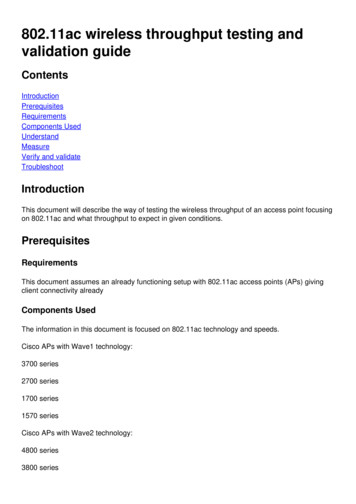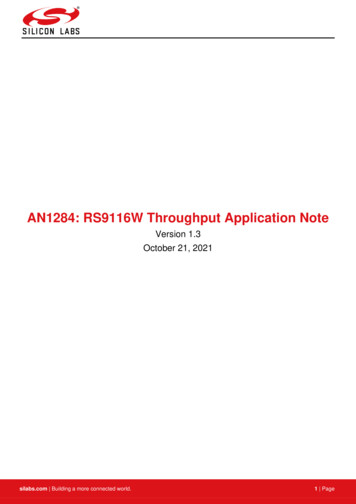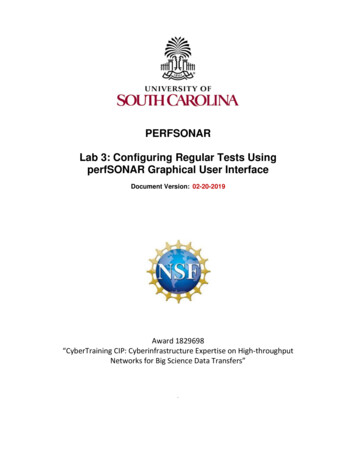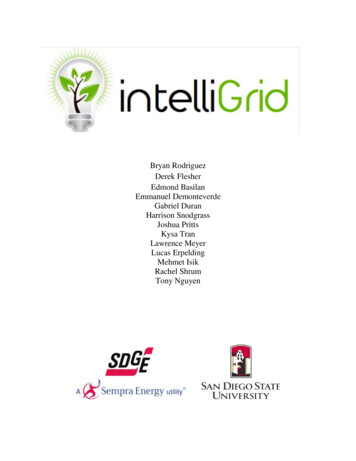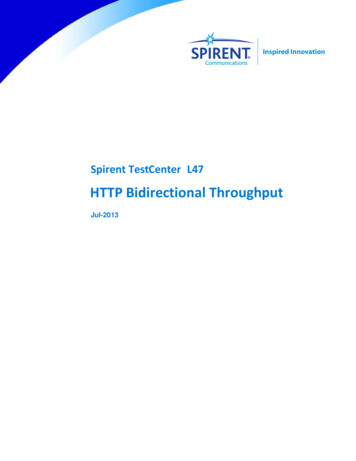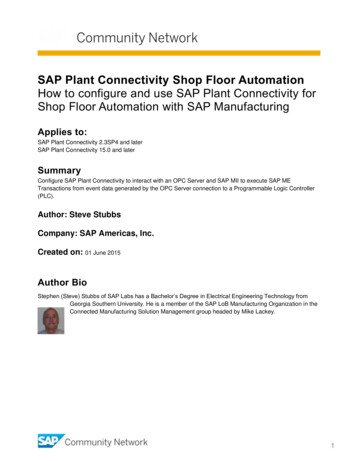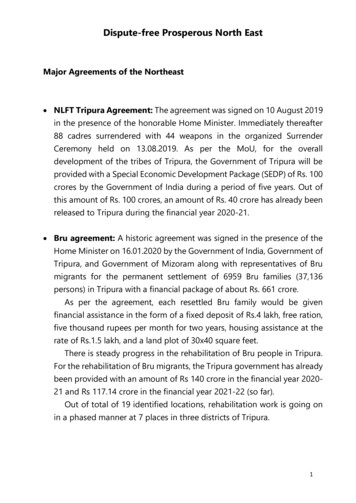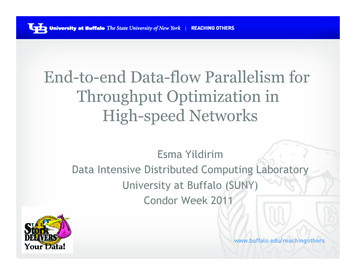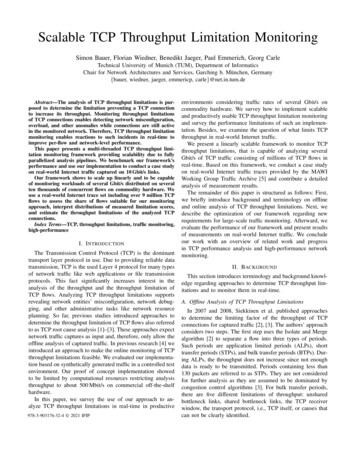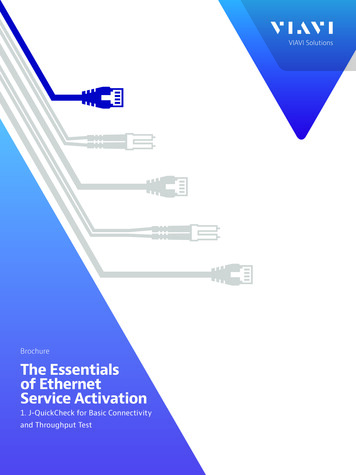
Transcription
BrochureThe Essentialsof EthernetService Activation1. J-QuickCheck for Basic Connectivityand Throughput Test
1. J-QuickCheck for Basic Connectivity and Throughput TestGlobal growth in communications and data services is drivingincreasing demand for Ethernet. As businesses and consumers demandKey Advantage:more and more data, the pressure is on service providers (SP) toVIAVI Solutions is the onlysupply reliable Ethernet with the capacity for growth – and to do itquickly. Customers want easy, well-priced access to reliablehigh-speed, cloud-based data services such as streaming, Internetof Things, and next-generation networks. At the same time, serviceproviders are keen to supply new services and benefit from new,growing revenues. To capitalize on demand and manage operationalcosts, service providers will rely on testing tools that help them turnvendor on the market to offerthis test. The time savings forservice activation can be quitesubstantial and potentiallyreduce total test time by 75%or more.up and monitor Ethernet connections quickly, safely, andcost-effectively with minimal complications.Connectivity and ThroughputThis brief will focus on the first test in Ethernet service activation, J-QuickCheck. The standalone test can berun within 2–3 minutes as a simple connectivity and throughput test, as opposed to a complicated manual test.This brief will concentrate on this standalone test; however, please note that J-QuickCheck can also be run as a“pre-test” in the RFC 2544 / Y.1564 workflow. As an embedded pre-test for the RFC 2544 / Y.1564 workflows,J-QuickCheck verifies basic connectivity and throughput of the network very quickly before significant time iswasted trying to run and the RFC 2544 or Y.1564 service activation test.Best Practice Workflow (Single and Multiple Services):1. J-QuickCheck: Basic Connectivity and Throughput Test2. Single-Service: Enhanced RFC 25443. Multi-Service: Y.1564 SAMComplete For Ethernet KPI Verification4. J-Proof Layer 2 Control Plane Transparency Test5. RFC 6349 Fusion TrueSpeed VNF: Layer 4 TCP ThroughputThis test workflow is applicable to Ethernet Business Services and Wireless Backhaul network topologies; a typicalEthernet business service network topology is shown in the following diagram.2 The Essentials of Ethernet Service Activation
1. J-QuickCheck for Basic Connectivity and Throughput TestEthernet Business Service Network Topology and Test CustomerEquipmentEnd to End Test with PortablesPortable to QT-600 ProbePortable to Switch using LBM/LBRThis Ethernet Topology system diagram shows that the VIAVI service activation solution can test betweenphysical instruments (portables), installed network probes (VIAVI QT-600), JMEP (VIAVI SFP-based technology),and even network devices which support Loop Back Messages and Replies (LBM/LBR). In the case of RFC 6349TrueSpeed, the TCP test can be run between portables, instruments, and software clients to accurately measureend-user experience at the TCP application layer.J-QuickCheck Test Component and BenefitsThe following table describes the distinct role of J-QuickCheck as well as the VIAVI enhancements that provideunique, valuable advantages:Table 1Service Activation TestJ-QuickCheckDescriptionVIAVI Advantage Standalone test Takes just 2-3 minutes for a simpleconnectivity and throughput test, asopposed to a complicated, time-consuming,manual testVIAVI is the only provider of this effectivetest. Our customers use J-QuickCheck savetime and effort by quickly verifying networkservice integrity in just 2-3 minutes. As a pre-test integrated within RFC 2544 /Y.1564, J-QC potentially reduces total testtime by 75% or more Immediately locates configuration errors andpitfalls (internal analysis) Automatically detects and configuresauto-negotiation settings (mismatches, andresultant half-duplex ports, are one of themost common causes of failed tests andpoor network performance) A “pre-test” integrated within RFC 2544 /Y.1564 Conducts basic connectivity and throughputtests prior to running the much moreextensive, complicated RFC 2544 and/orY.1564 tests3 The Essentials of Ethernet Service Activation
1. J-QuickCheck for Basic Connectivity and Throughput TestService Activation TestDescriptionVIAVI AdvantageIdentify auto-negotiationsettings Automatically configures auto-negotiationsettings to match the network This is common user error which can lead tofalse and very poor RFC 2544 / Y.1564 results.This step eliminates auto-negotiationmisconfiguration.Automatically DiscoverVLAN of remote loop-backdevice A “VLAN loop scan” is conducted by the localTBERD/MTS to determine the VLAN of theremote loopback device Misconfiguration of the remote device VLANis very common. Significant time is wastedwhen the technician must manually entercorrect VLANs. Automatically detecting theVLAN provides enormous time savings whichcan eliminate hours of wasted time.Verify connectivity to theremote loop-back device The local TBERD/MTS can verify connectivity(both Layer 2 and 3) and activate a VIAVIloop, soft loop, and hard loop This feature eliminates the need for the userto configure detailed set-ups for a test or toactivate the loop back mode.Quick throughput test This is a rapid throughput test, to verify thatthe network is active and fundamentally“sound” VIAVI is currently the only vendor on themarket to offer this option. As a standalonetest, it can be run as a simple connectivityand throughput test (2-3 minutes) asopposed to a more time-consuming manualtest. Some providers use this as the sole testto verify network service integrity in a veryrapid manner.Easy Set-up and TestingThe following is a screenshot of the J-QuickCheckconfiguration screen on the local TBERD/MTS. Fora Layer 2 test, no remote device configuration isrequired. For Layer 3 tests, the user must only enterthe management IP address of the remote loopbackdevice, press Start and the TBERD automatically cyclesthrough each step detailed in Table 1.J-QuickCheck User Interface4 The Essentials of Ethernet Service Activation
1. J-QuickCheck for Basic Connectivity and Throughput TestTime-Saving Factors with the J-QuickCheckAuto-negotiation IssuesWhen a local test unit is connected to the network, the test unit and networkequipment (e.g. Ethernet switch), must negotiate to the proper full-duplexlink speed or the interface will default to half-duplex. If the interface cannotnegotiate properly and enters half-duplex state, then an RFC 2544 / Y.1564 testwill falsely report a very low throughput for a given CIR. As an example, a CIR of100 Mbps may only achieve 10 Mbps (or less) if the link is set for half-duplex.In the example screen shown here, a switch port failed to auto-negotiate. Thenegotiation process fell back to half duplex (HD) mode and the J-QuickChecktest immediately identified the condition.The J-QuickCheck test detects the settings of the connected test port andautomatically ensures that maximum full duplex speed is configured beforerunning the much longer RFC 2544 / Y.1564 test. This can save hours of techniciantest time and eliminates the need for the technician to contact advanced fieldsupport (which saves even more service provider time).Mis-configured VLANTraditionally, the technician must enter the correct VLAN on the local test set. Many times, this VLAN is incorrector the technician is not even aware that the network is using VLAN tags. An example would be when the networkis configured to use VLAN 202 between the local and remote test device. If the technician does not enter a VLANor enters the incorrect VLAN, the remote device will never see the loopback commands. This can waste significantamounts of time since the technician must contact advanced engineering or the Network Operations Center (NOC).The situation can be even more problematic when the network is not well documented.The J-QuickCheck VLAN scan test (due early 2017) automatically sends loop “hello” commands to all 4096 VLANsand provides a list of remote devices which reply on a VLAN (with the VIAVI device ID). This scan takes about tenseconds to complete. The time-savings is significant, as VLAN misconfiguration is one of the most common testconfiguration errors.Additionally, the J-QuickCheck can detect and activate the appropriate loop for the following cases:y VIAVI loop: a device that responds to VIAVI Loop Up commandy Soft loop: a device such as a network interface device (NID) or switch that is already in local loopback andswaps MAC addressesy Hard Loop: a “cable loopback” in which a device does not swap MACs5 The Essentials of Ethernet Service Activation
1. J-QuickCheck for Basic Connectivity and Throughput TestQuick Throughput TestAs a standalone test, J-QuickCheck can be run as a simple 2-3 minute throughput test, as opposed to a morecomplicated manual test (where time is quite variable). For a manual throughput test, the process can be quitetedious and requires the verification of auto-negotiation, correct VLAN, etc. followed by the proper configuration orloopback of the remote device.J-QuickCheck eliminates these configuration errors and conducts a very simple throughput test that is easy torun no matter the experience level of the user. Some network providers use this as the sole test to verify networkservice integrity in a very rapid manner.The following figure illustrates the simple set-up options for the test including Load, Test Duration, andFrame Length.After the test has completed the user can see the basicresult of Measured Throughput (at right) and then drillinto to see some more detailed errors such as Errored,Out of Sequence (OOS), and Lost Frame counts (below).6 The Essentials of Ethernet Service Activation
1. J-QuickCheck for Basic Connectivity and Throughput TestAs a pre-test integrated within RFC 2544 / Y.1564, J-QuickCheck eliminates these misconfiguration problemsaltogether by running a very short throughput test that provides immediate feedback (within seconds) to the userabout whether a configuration error is causing a wide discrepancy in results. By determining that a policer (etc.) isin the network in seconds versus many minutes or hours, J-QuickCheck can dramatically reduce the time it takes forthe overall RFC 2544 / Y.1564 test.ConclusionEthernet service activation is your first step to ensure customer satisfaction. Service providers need toconduct service activation set-up in a cost-effective manner. VIAVI’s solution for the J-QuickCheck test providesan advantage in time, efficiency and accuracy to make your service activation workflow as smooth and easyas possible.For more details on VIAVI test and measurement solutions, please go to viavisolutions.comContact Us 1 844 GO VIAVI( 1 844 468 4284)VIAVI SolutionsTo reach the VIAVI office nearest you,visit viavisolutions.com/contact 2021 VIAVI Solutions Inc.Product specifications and descriptions in thisdocument are subject to change without notice.Patented as described tfs-nse-ae30186112 900 0517viavisolutions.com
Quick throughput test This is a rapid throughput test, to verify that the network is active and fundamentally "sound" VIAVI is currently the only vendor on the market to offer this option. As a standalone test, it can be run as a simple connectivity and throughput test (2-3 minutes) as opposed to a more time-consuming manual test.
